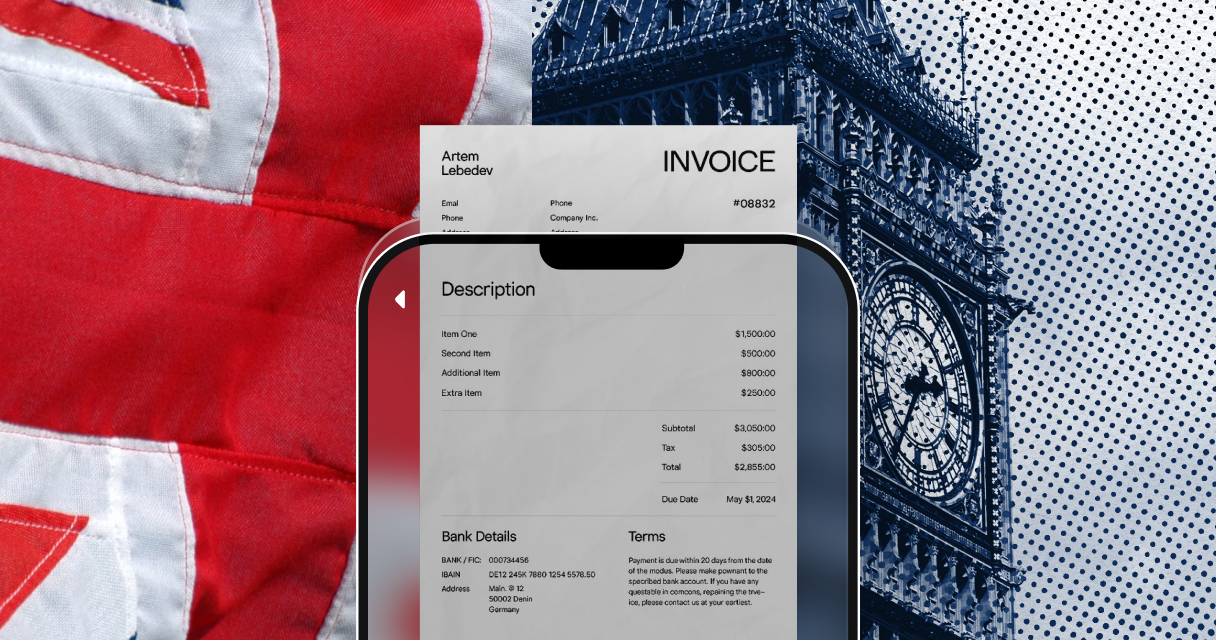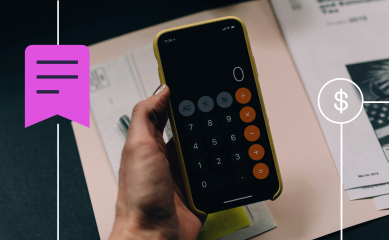
E-invoicing is rapidly reshaping financial operations for UK businesses. This guide explores how structured digital invoices slash processing times by up to 80%, save small businesses over £11,000 annually, and improve accuracy in VAT returns. While not yet mandatory for B2B transactions, e-invoicing is already required for contracts involving public bodies like the NHS and is gaining momentum through government consultations. The UK is aligning with global trends especially EU and Latin American adoption to modernise its tax systems, cut fraud, and drive automation. Learn the difference between real e-invoicing and PDFs, how to prepare your business for the shift, and why integrating with systems like PEPPOL and Making Tax Digital can future-proof your operations. Discover how AI and automation are transforming invoice processing and why early adopters will gain a competitive edge ahead of potential 2030 mandates.
E-invoicing is changing the way businesses handle their financial documents. Small businesses can save about €13,500 every year by cutting their invoice processing time in half. The digital world of UK businesses has embraced this change. Research shows that e-invoicing lets buyers and suppliers exchange invoices automatically. This boosts productivity, helps business cash flow, and cuts down errors in tax returns.
B2B transactions in the UK don't require e-invoicing yet. However, things are changing faster than ever. HMRC now requires electronic invoicing systems for any payments involving public bodies like the NHS, government departments, and local councils. This matches what's happening worldwide. A 2024 report shows the global e-invoicing market will triple in size by 2028. Businesses need to learn about these upcoming changes and get ready for this new age of digital financial management.
What is E-Invoicing and Why It’s Gaining Momentum
E-invoicing brings a fundamental change to business transactions. True e-invoicing uses structured data exchange between financial systems through standardized formats, unlike traditional paper or PDF invoices.
How e-invoicing is different from PDFs and paper invoices
Many businesses think they're using e-invoicing just by emailing PDF documents. Real e-invoicing completely removes the need for manual data entry. The system transmits machine-readable data directly between accounting systems instead of sending visual documents that need interpretation.
The biggest differences include:
- Automation: E-invoices flow automatically into recipient systems without manual intervention
- Data integrity: Information moves unchanged from sender to receiver, which eliminates transcription errors
- Enhanced security: Digital signatures and encrypted transmission protect sensitive financial data
- Compliance tracking: Built-in validation makes sure regulatory requirements are met before transmission
Global adoption trends and EU leadership
E-invoicing has changed from optional to mandatory across Europe. Italy led this change and reported huge drops in VAT gaps and tax fraud. The EU's Directive 2014/55/EU made e-invoicing mandatory for public procurement, which created a standard framework that sped up adoption.
Latin American countries made e-invoicing mandatory years ago to curb tax evasion. Their soaring win has shaped global policy approaches and shown both fiscal and efficiency benefits.
Why the UK is catching up in 2024
The UK has fallen behind in e-invoicing adoption despite being a financial hub. Several factors explain this push in 2024:
Brexit created new trading frameworks, which gave a chance to modernize financial systems. The government's digital transformation plans fit perfectly with e-invoicing principles.
Remote work became essential during the pandemic, which exposed weaknesses in paper-based processes. Companies using digital invoicing adapted better than those stuck with physical documents.
The UK's approach is different from the EU's. It starts with public sector requirements before moving to private businesses. This step-by-step implementation gives companies time to adjust their systems and train their staff before full compliance becomes mandatory.
UK businesses operate internationally, which makes matching global standards crucial to stay competitive in cross-border trade relationships.
How E-Invoicing UK Rules Will Impact Businesses
The UK's shift toward e-invoicing represents a major milestone that will transform financial operations nationwide. This digital transformation will impact businesses way beyond the reach and influence of basic document exchanges.
New requirements for public and private sectors
E-invoicing remains mandatory only for specific public sector contracts, mostly with NHS Trusts. The government has launched a detailed consultation to break down standardized e-invoicing options across public and private sectors. This review looks at different models to implement the system, weighing both mandatory requirements and voluntary adoption.
The consultation also looks at up-to-the-minute data analysis possibilities alongside e-invoicing requirements. UK businesses should prepare for new standards that might become mandatory in stages. These changes could start with business-to-government transactions before expanding to the wider private sector.
Expected benefits: speed, accuracy, and cost savings
E-invoicing brings substantial financial benefits. Moving to this system cuts processing costs by 60-80% according to industry estimates. One NHS trust saw amazing results - their processing times dropped from 10 days to under 24 hours. Payment processing became twice as fast.
The system eliminates the 10% error rate linked to manual data entry completely. Better accuracy in tax reporting follows naturally, as automated data capture reduces VAT return mistakes and helps maintain tax compliance.
E-invoicing also creates better security protocols. Machine-readable formats minimize fraud risks through encryption and secure transmission channels.
Implications for SMEs and accountants
Small businesses can benefit by a lot from these changes. Research shows SMEs save over £11,000 each year by cutting down invoice processing time. This tackles a huge problem, as the Department for Business and Trade found that administrative errors cause 24% of late payments - issues that e-invoicing fixes.
Accountants will see increased efficiency and less workload during this transition. The Chartered Institute of Taxation suggests that e-invoicing software should handle tax legislation changes while maintaining clear standards for operability and security.
Accounting bodies stress that successful implementation needs careful planning and targeted support. Many countries already use mandatory e-invoicing, which puts UK businesses at a competitive disadvantage without coordinated policy.
How to Prepare Your Business for E-Invoicing
Getting ready to move to e-invoicing needs a step-by-step approach that starts before you implement it. Your business should look at its current invoicing methods and spot problems that digital tools can fix.
Steps to choose the right software
You need to evaluate your organization's needs before selecting e-invoicing software. Here's what to think about when comparing solutions:
- How well it works with your existing accounting systems and ERP tools
- Whether it follows UK regulations and international standards
- Room to grow as your business expands
- Support for different invoice formats and channels
- Security features like encryption and ways to prevent fraud
Studies show that e-invoicing cuts invoice costs by 60-80%. This makes the original investment worth it. A full picture of both immediate costs and future savings will help you decide.
Training staff and updating workflows
Your team needs good change management strategies to adopt the new system. Create detailed training programs that match different job roles in your organization. Staff learn best through documentation, video guides, and hands-on practice sessions.
The best way to switch over is to start small. Test the system with a few suppliers and customers before rolling it out completely. This lets you make adjustments before wider implementation.
Using Peppol and other global standards
The UK doesn't require specific e-invoicing standards right now, except for NHS suppliers who must use the PEPPOL network. Most EU countries, Australia, Japan, and Singapore use this framework. PEPPOL standards help your business combine smoothly with international partners and government organizations.
Integrating e-invoicing with tax and compliance systems
E-invoicing works well with Making Tax Digital (MTD), which started in 2019. These systems can work together to automate tax reporting. This cuts down errors that happen with manual data entry, which usually runs at about 10%.
Keep track of how things work after implementation and adjust as needed. E-invoice data flows straight into tax reporting systems. This helps businesses stay compliant while making their financial tasks simpler.
What the Future Holds for E-Invoicing in the UK
The UK's e-invoicing landscape is changing faster, with major developments expected in the next five years. The UK government now focuses on creating well-laid-out standards instead of just promoting voluntary adoption for digital financial transformation.
Potential for mandatory B2B invoicing
The UK evaluates various e-invoicing implementation approaches through a public consultation from February to May 2025. This consultation will help decide if e-invoicing becomes mandatory for businesses. Experts expect an announcement in the Autumn Budget of 2025 based on the consultation timeline. Full implementation might happen by 2030.
This schedule matches the European Union's VAT in the Digital Age (ViDA) proposals that require e-invoicing for cross-border EU transactions by July 2030. Britain's post-Brexit status means EU regulations don't apply directly, yet maintaining compatibility with trading partners makes economic sense.
The government prefers a decentralized model over centralized systems like those in Italy and Chile. Businesses can exchange e-invoices directly through software providers instead of sending all invoices through a government platform.
Integration with digital tax reporting
Centralized and decentralized e-invoicing models provide up-to-the-minute data analysis opportunities to tax authorities. This capability revolutionizes tax compliance by:
- Making VAT returns more accurate through automated data submission
- Helping HMRC target compliance efforts better
- Reducing the VAT gap, which stands at £9.5 billion in 2023-24
This integration supports the broader Making Tax Digital strategy and simplifies tax administration while improving compliance rates.
Opportunities for automation and AI in invoicing
E-invoicing creates new paths for advanced automation. AI-powered systems now revolutionize invoice processing, with 36% of finance leaders using AI for accounts payable/receivable tasks.
These smart systems analyze historical payment data to predict cash flows, spot duplicate invoices, and identify potential fraud risks early. Machine learning parsing of machine-readable documents achieves accuracy rates above 90%.
Finance professionals move toward more strategic roles that focus on analysis and problem-solving as automation handles routine tasks. This change brings efficiency and transforms financial operations in UK businesses completely.
Conclusion
E-invoicing marks a watershed moment for UK businesses in 2024 and beyond. The change from traditional paper-based systems to structured digital formats brings clear advantages. Most businesses will experience dramatic reductions in processing times, fewer errors, and substantial cost savings—benefits that European organizations already enjoy.
Numbers tell the story clearly. Small businesses can save around £11,000 each year. Larger organizations might cut processing costs by up to 80%. The original implementation needs careful planning, but businesses of all sizes will find the long-term return on investment worthwhile.
UK companies can't afford to wait for regulatory mandates that could leave them trailing competitors. Many countries have made e-invoicing systems mandatory, and late adopters now struggle to keep pace. The upcoming consultation will likely create a phased implementation plan that starts with public sector requirements before reaching private businesses.
E-invoicing's connection to broader digital tax initiatives deserves attention. This digital transformation lines up with Making Tax Digital goals and could change tax compliance through automated data submission and better accuracy. Companies that adopt e-invoicing standards early will be ready when new digital requirements emerge.
Businesses that start planning now will make the smoothest transitions. Your priority list should focus on evaluating current processes, choosing the right software, training staff well, and connecting with existing systems. A step-by-step approach produces the best results with minimal disruption.
The digital age belongs to businesses that welcome change. E-invoicing is nowhere near just a compliance requirement—it opens doors to boosted efficiency, better cash flow, and smarter financial management. UK businesses stand ready to revolutionize their financial operations and succeed in our increasingly digital economy.
